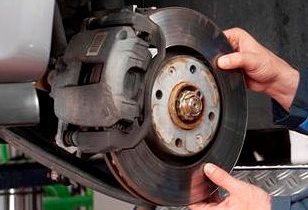The fluid in your car brake system is there to transfer pressure to each brake evenly.
If air enters your car braking system, then they will feel soft and spongy and braking performance will be reduced.
The reason for this is that air will compress more than brake fluid when under pressure.
Think of a bicycle pump with the end blocked up. When the pump has air in it, you will be able to push the plunger in so far until the the air is compressed that much that you cannot push any more. If the bicycle pump was full of brake fluid instead, you would not be able to push the plunger in at all because you could not compress it with the pressure you could apply.
So any air in the car braking system will affect its efficiency, you may find yourself having to push the brake pedal down further to get the same stopping force. This is because the air is easier to compress.
Air could enter the system if there is a leak or if you have had to renew certain brake parts.
Bleeding your brakes is actually the method of removing the air from the braking system ….
“Bleeding the air out”.
What do I need
1. An assistant to pump the car brakes.
2. A brake bleeding kit (best value) or clear pipe and disposable bottle.
3. A suitably sized spanner, probably 8 or 10mm.
How do I bleed the brakes then ?
PLEASE READ THROUGH THE INSTRUCTIONS FULLY BEFORE YOU START YOUR BLEEDING.
In order to ensure that all the air is removed from the cars brake system, it will be necessary to bleed the brakes on all four wheels.
The order in which you perform the bleeding is not critical but it is recommended that you start at the rear and do these two wheels first and then the front two.
This will minimise the amount of potential cross-contamination between the new and old brake fluid.
1. Jack up and secure the car, remove the wheel (see article- How to jack up your car) and locate the bleed screw on the rear of the brake caliper body. It will more than likely have a protective rubber cover over it that you will need to remove and refit later.
PHOTO OF BLEED SCREW
2. Place your spanner onto the bleed screw (probably a 10mm spanner)
3. Place one end of the clear plastic hose over the nipple (end) of the bleed screw.
4. Place the other end of the hose into the disposable bottle. If you already have a brake bleeding kit then this is what you will be using.
5. Place the bottle for waste fluid on top of the caliper body or drum assembly. Hold the bottle with one hand and grasp the wrench with the other hand.
6. Instruct the your assistant to pump the brake pedal three times, and then hold the pedal down firmly. At this point your helper should NOT to release the brakes until told to do so.
7. Loosen the bleed screw by Å’ turn to release fluid into the clear pipe. The screw only needs to be open for one second or less. (The brake pedal drop down as the bleed screw is opened. Your assistant should still keep their foot firmly on the brake pedal.)
8. Close the bleed screw gently and not using too much force.
9. Instruct your helper to take their foot off the brake pedal.
Note: do NOT release the brake pedal with the bleed screw is open, as this will suck air back into the system.
10. Look at the brake fluid inside the clear pipe for air bubbles.
11. Continue with steps 1 to 10 until there are no more air bubbles visible. You should find yourself repeating this process 5-10 times for each wheel.
12. After bleeding each wheel, check that there is sufficient brake fluid in the brake reservoir in the engine bay (where you top it up).
13. Ideally start at the right rear wheel, and then left rear, right front, left front.
14. Before you drive anywhere, make sure that you have refitted everything, bleed nipple covers, wheels, wheel nuts etc………… and then sit in the car and check the feel of the brakes, they should be firmer than they were before.
Once you are confident that they feel better and that the car is safe, take the car for a steady drive. Check the brakes before you get up to any great speed, they should feel firmer and more responsive.
Video.
This is one of the more helpful videos on YouTube. We’ve been through a few and this is one of the most informative.
It shows you how to use a one-man brake bleeding kit – these are readily available on ebay.
WARNING
Brake fluid is very corrosive, keep it off your hands and off the paintwork of your car. Make sure that you clean up any spills with a rag and ensure that you dispose of your waste brake fluid in a responsible and safe manner.
NOTE
Bleed nipples, these can be an absolute pain if you have not got the correct size/suitable spanner or it is corroded and will not loosen off.
If you experience this problem, then get hold of a new replacement bleed nipple (they are very cheap) and use a ‘locking wrench’ (sometimes referred to as mole grips) to get the nipple off.
Source-http://www.carbasics.co.uk/blog/how-to-bleed-your-car-brakes/

